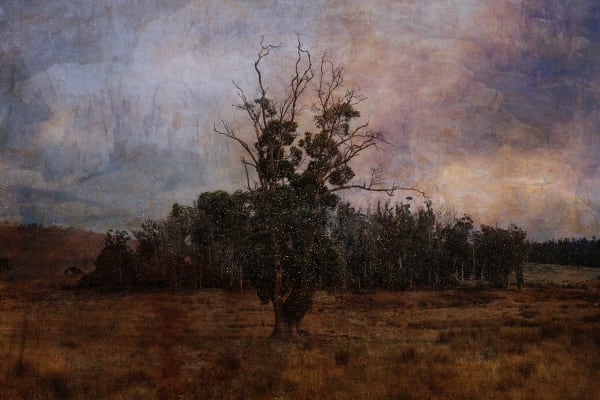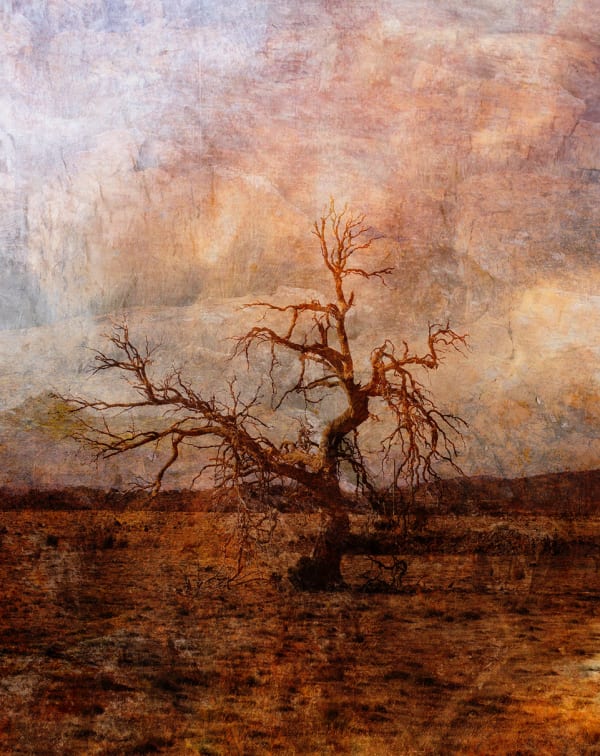Troy Ruffels: Weathering - Burnie Regional Gallery
Entangled: Weathering at the Edge
Weathering implies that what seems certain - the stone, the mountain, the ancient tree – is profoundly impermanent. Pause long enough, watch the time slip by: the stone breaks open, the seeking tide rises yet again. We are all held in this process of entangled decay.
Troy Ruffels’ body of work wears its name on its surface. Saturated with texture, marked and scratched, the familiar landscapes of Tasmania’s north-west that ground his work have been become immersed in a thickened atmosphere. Building on previous work that has tracked the incursions of flood and fire into the landscape, here, the incoming pressure of climate emergency becomes a suffocating apprehension of the fates already held in the air and sea. Perceiving weather and weathering requires us to sense patterns that go beyond the visible, that go beyond this present moment into more-than-human durations. These images hold a breath-pause of a single encounter, stilled to echo into a suspended duration that is no and all time. They convey the insistence of the present filled with the time yet to come. Yet, for all the weight and pressure of this charged atmosphere, the printed surface still retains a yearning luminosity.
Recurring through the work is a westering light: the light that is tremulously, falteringly retreating. It is a light that withdraws into the haunted twilights of myth and memory, that sits illuminates the liminal edgelands. The works hold a preoccupation with the capturing and veiling of light that takes the mechanical logic of photography and finds in it a language for transcendence. For the westering light is also the glowing beacon, the day’s final burst of generosity: a golden honey light, pouring viscously to fill and smooth, permeating all it touches.
The light and the landscape together anchor this body of work in Australian painterly tradition, its bleached searching for ways to make sense of the particular shapings of trees and grass and sky. Ruffels takes up the Australia pastoral landscape as a space that subtly reveals its devastation, a composed semblance of reassuring familiarity that covers cultural and ecological damages and dispossessions. The lone paddock trees are left stranded by the tide of agriculture. These landmarks bear the weight of years, bared branches testifying to the struggle of solitary existence, isolated from the ecological exchanges with others of their kind. They are gnarled and aged, skirted by the grass that has been grazed and ploughed and cropped, where the next generation has not been nurtured to grow.
Yet, presence – the statement of being in and holding space – mean that these solitary sentinels are not fully alone. The act of seeing, of recognising, of witnessing, calls us as viewers into presence with them. With branches like roots like rhizomes, the silhouettes sketch out a web of interconnections between human and other, between our loaded and limited ways of seeing and this marked and weathered bark that bears the traces of insect and fire, lichen and storm. They ask: how are we to be, here, on this edge? How are we to be, amidst this entanglement? We know that the trees call for the rain. What needs do our broken stone-hearts, our slow shattering of erosion-destruction, call into being? Weathering holds a promise of transubstantiation, an unseen but unceasing transformation of matter, in which the breaking down brings elements together the something new may yet some to be.
Dr Karen Hall
-
 Troy RuffelsHeartland, 2021digital print on aluminium panel220 x 330cmEdition of 6 plus 1 artist's proofAU$ 18,000.00
Troy RuffelsHeartland, 2021digital print on aluminium panel220 x 330cmEdition of 6 plus 1 artist's proofAU$ 18,000.00 -
 Troy RuffelsCicadas, 2021digital print on aluminium panel220 x 330cmEdition of 6 plus 1 artist's proofAU$ 18,000.00
Troy RuffelsCicadas, 2021digital print on aluminium panel220 x 330cmEdition of 6 plus 1 artist's proofAU$ 18,000.00 -
 Troy RuffelsNight Sky, 2021digital print on aluminium panel220 x 330cmEdition of 6 plus 1 artist's proofAU$ 18,000.00
Troy RuffelsNight Sky, 2021digital print on aluminium panel220 x 330cmEdition of 6 plus 1 artist's proofAU$ 18,000.00 -
 Troy RuffelsWater, Branch, Earth and Rust, 2021digital print on aluminium panel220 x 330cmEdition of 6 plus 1 artist's proofAU$ 18,000.00
Troy RuffelsWater, Branch, Earth and Rust, 2021digital print on aluminium panel220 x 330cmEdition of 6 plus 1 artist's proofAU$ 18,000.00 -
 Troy RuffelsIslands within islands, 2021digital print on aluminium panel220 x 330cmEdition of 6 plus 1 artist's proofAU$ 18,000.00
Troy RuffelsIslands within islands, 2021digital print on aluminium panel220 x 330cmEdition of 6 plus 1 artist's proofAU$ 18,000.00 -
 Troy RuffelsSentinels, 2021digital print on aluminium panel145 x 115cmEdition of 6 plus 1 artist's proofAU$ 7,600.00
Troy RuffelsSentinels, 2021digital print on aluminium panel145 x 115cmEdition of 6 plus 1 artist's proofAU$ 7,600.00 -
 Troy RuffelsWeathered Ground, 2021digital print on aluminium panel145 x 115cmEdition of 6 plus 1 artist's proofAU$ 11,400.00
Troy RuffelsWeathered Ground, 2021digital print on aluminium panel145 x 115cmEdition of 6 plus 1 artist's proofAU$ 11,400.00 -
 Troy Ruffels, Weathering, 2021
Troy Ruffels, Weathering, 2021 -
 Troy RuffelsWinter Vale, from Weathering, 2021digital print on aluminium panel220 x 330cmEdition of 6 plus 1 artist's proofAU$ 18,000.00
Troy RuffelsWinter Vale, from Weathering, 2021digital print on aluminium panel220 x 330cmEdition of 6 plus 1 artist's proofAU$ 18,000.00










